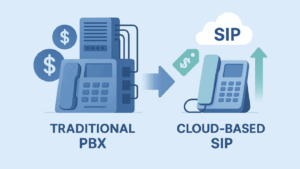
How Much Bandwidth Do I Need for SIP Trunking?
At your business, the phone is constantly ringing — and that’s a good thing. After all, every phone call is an opportunity for you to boost your reputation and, of course, make money.
But how can you take your communications to the next level?
Many companies are turning to Session Initiation Protocol (SIP) trunking, which allows you to receive phone and other communication services via the internet. In fact, the SIP trunking market size is expected to increase from $7.63 billion to $12.70 billion from 2018 to 2023.
With the right provider, you can quickly extend your traditional phone system into the cloud. The SIP trunking process is relatively easy and can save you on costs in the long run.
At the same time, you may be wondering how much bandwidth you need to take advantage of SIP trunking. This is an essential question, as your bandwidth amount will have an effect on both general reliability and voice quality.
Here’s a rundown on you can determine the proper bandwidth amount based on your business needs.
Let’s get started!
Background on SIP Trunking
When the telephone network known as the Private Branch Exchange (PBX) made its debut years ago, companies started calculating their estimated phone usage. They did this to figure out the number of trunks that would need to enter and leave their buildings.
However, with SIP, the focus is more on bandwidth versus physical trunks. That’s because SIP replaces your traditional phone lines with Voice over Internet Protocol, or VoIP.
VoIP offers the benefit of providing a lot more flexibility when compared with traditional trunks. So, it’s excellent for delivering bandwidth.
Let’s take a look at three important steps you can take to determine the bandwidth you need when using SIP trunking.
1. Determine Your Number of Phone Calls
First and foremost, you need to figure out how many calls your business may receive at the same time. This is critical because every call takes up bandwidth.
In addition, you’ll need this information to determine how many SIP channels you’ll need. After all, every channel supports a single concurrent outbound or inbound phone call. So, do your due diligence when it comes to obtaining a figure.
To arrive at an accurate figure, look at the number of outbound and inbound calls your business needs to be able to support. Your data records regarding your calls may help you to determine these figures.
If you do not have access to such data, you can make an assumption based on how many employees are at your location and the nature of their work.
Remember that not every employee of yours is constantly on the telephone. So, don’t make the mistake of thinking that your number of phone calls is equal to your number of staff members.
The majority of companies have one concurrent telephone call in a group of three to four employees.
Let’s say your company has 10 employees. As a general rule of thumb, you may have between three and four simultaneous phone calls.
However, this may be very different for an organization whose business is call-intensive. For instance, maybe your business has a lot of inside sales activity, or perhaps you have a busy call center.
2. Determine Your Voice Codec
This is yet another important step in determining your bandwidth needs for SIP trunking.
“Codec” refers to codec-recorder — a compression protocol. Codecs basically convert audio signals into a compressed form so that they can be transmitted. Then, the codecs convert the signals back into the uncompressed form for replay.
However, different codecs require different bandwidth amounts. For this reason, you’ll want to check with your provider on which codec it uses. You should also ask about the amount of bandwidth that the codec needs per call.
Here are a few of the most frequently supported and popular codecs:
- G.711 Codec: This is the standard responsible for digitizing an analog audio signal; its bandwidth requirement is 64 Kbps.
- G.722 Codec: This is the standard responsible for providing speech that is higher fidelity; its bandwidth requirement is 48-64 Kbps.
- G.729 Codec: This standard is responsible for digitizing analog audio signals using an 8:1 compression rate algorithm; its bandwidth requirement is 8 Kbps.
- G.726 Codec: This standard is mostly used for international trunks; its bandwidth requirement is 16-40 Kbps.
The majority of service providers use G.711. That’s because it ensures top-tier voice quality as long as you receive a SIP trunk through a dedicated data line.
Keep in mind that the requirements listed for bandwidth above don’t include the extra 23 Kbps needed for Internet Protocol (IP) overhead.
So, this means that G.711 requires a bandwidth amount of 87 Kbps per call.
G.711 offers voice quality similar to that of a telephone call being made from one landline to another. Meanwhile, G.729’s quality mirrors what you’ll get when making a cell phone call.
3. Do Your Number Crunching to Figure out How Much Bandwidth You Need for SIP Trunking
Finally, you’ll need to crunch some numbers to find out the bandwidth amount your business needs.
To do this, simply multiply the number of phone calls you expect your staff to make by the necessary bandwidth amount. This result will tell you the lowest bandwidth amount your company will need to make voice calls.
Note that other data-related traffic will likely consume some of your resources during the business day, too. So, it’s a smart idea to add a minimum of 10% additional capacity to your result.
Also, remember that the bandwidth amount you’ll actually experience on a regular basis may differ from what you initially expected to get. That’s why it’s important to run a speed test on a computer with an Internet connection to see what your real-world bandwidth numbers are.
A wide number of complimentary speed tests are available, including a popular one by Ookla.
Your speed test should give you information on your download and upload speeds. It’s best to use the figure that is lower — typically the upload number — to perform your calculations.
Note that with the majority of these speed tests, you’ll find out what your speed is in Megabits a second, or Mbps. Therefore, you’ll have to multiply this number by 1,000 so that you can get your speed in Kilobits a second, or kbps.
Example of Bandwidth Calculations
Let’s say that your business expects to have six concurrent calls.
In this situation, your per-call bandwidth requirement according to your vendor may be 85 kbps.
In this case, you’ll multiply six by 85 to get 510 kbps for your bandwidth.
Now, let’s say you discover that your upload speed is 2.50 Mbps. Multiply this by 1,000 to get a total of 2,500 kbps.
To get the total number of calls your business can support, divide 2,500 kbps by 85. The number of calls is 29, which means your connection is beyond adequate for supporting six concurrent calls.
How We Can Help
We are a leading SIP trunking service provider. Our service conveniently works with the Internet connection you currently have. It also supports all SIP-compliant devices.
We can provide SIP trunks immediately and offer a complimentary trial including an hour of calling. We do this to make sure that everything functions properly for you.
We also have a user-friendly yet powerful control panel online that will allow you to manage your company’s phone numbers and SIP trunks. This self-service tool is just another example of how we constantly try to put your needs first.
Why Choose Us?
We are passionate about reducing costs and boosting flexibility for customers through our automated services.
We design all of our offerings to be completely automated, as this limits the human intervention needed to run our business.
We use automated processes to complete billing, ordering, and provisioning and we can deliver a SIP trunk to a customer within seconds.
If you’re looking for a new phone number, you can just use our phone number inventory to see what’s available in your area code. Then, you can pick the number you’d like and purchase it. It will be ready for use immediately.
Meanwhile, if you’re interested in adding some channels to your SIP trunk, you can do this online with ease. We’ll even automatically pro-rate this for you.
You can verify details in your call records right after a phone call has ended.
Our Customer Support Focus
In addition to offering low-cost SIP trunking services, we pride ourselves on being first-rate customer service providers. That’s because our company’s staff members are both compassionate and experienced.
We’ll help you to determine how much bandwidth you need to take advantage of SIP trunking. And we’ll work closely with you in configuring your SIP trunk so that it’ll work with your desired softphone or IP-PBX brand.
Get in touch with us to learn more about our SIP trunking services and how they can elevate your business today.


